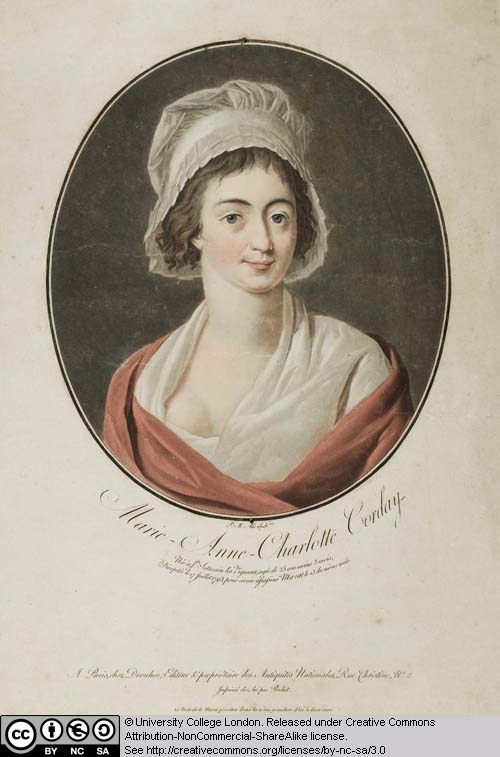10 Marie-Anne-Charlotte Corday

Pierre-Michel Alix
(1762 – 1817) after Jean-François Garneray (1755 – 1837)
Marie Anne Charlotte
Corday, 1793
Stipple engraving with
hand-colouring
Published by Drouhin,
Éditeur & Proprietaire des Antiquités Nationale, Rue de Christine, no. 2.,
[1793]
In the months following Charlotte Corday’s execution for the
murder of Marat, images of her that stressed her beauty, virtue and stoicism
began to appear in the moderate press. These constructed her as a saviour who
had rid the nation of a terrible monster. Such images were unequivocally
denounced by followers of Marat who, fearful of a cult forming around Corday,
wanted the memory of her consigned to oblivion. Yet the popularity of such
prints was hard to suppress given that she had actively set about the
construction of her own legend during her trial and imprisonment. This legend
not only survived the immediate aftermath of her actions but endured throughout
the nineteenth century.
Corday is portrayed here with hair cropped short in
preparation for the guillotine, yet no fear is detectable on her countenance.
She is depicted fresh-faced and rosy-cheeked, her cool grey eyes staring calmly
from the oval frame. Corday had amazed her contemporaries with the composure
and sang froid that she exhibited at her trial and on the way to the
guillotine. Her sympathisers revered these qualities and one Girondin who
witnessed her performance noted, ‘she is leading us to our death, but she is
showing us how to die.’
The curve of Corday’s breast is carefully delineated by the
engraver, which draws our attention to her youthful feminine charms (another
talking point), and serves to construct her as a nurturing, perhaps even
maternal figure. This is at odds with the fact that a post-mortem revealed she
was a virgin, a point used by the radical left to denounce her as ‘unnatural’.
Although French women married at an average age of 24-26, and Corday’s
virginity was not in any way exceptional, according to revolutionary rhetoric,
a woman should have produced a brood of little revolutionaries by the age of
twenty-five. The inclusion of her full Christian name, Marie-Anne-Charlotte is
perhaps significant in this respect. It evokes that other paradoxical virgin,
the Holy mother Mary, and places
This print was one of a pair, and the publication line
specifies that a portrait of Marat in the same size and format will be
published within two months. Might the order in which they were published
suggest that, among the publisher’s clientèle, there was a greater demand for a
portrait of Corday, than for the one of Marat?
Licensed under the Creative Commons Attribution Non-commercial Share Alike 3.0 License
This resource has been released as an open educational resource (OER) on a Creative Commons 'Attribution Non-commercial Share Alike' license. This means that once downloaded, content can be modified and improved to complement a particular course. This requires, however, that improvements are recycled back into the OER community. All content present at the time of download must be accordingly credited and, in turn, novel content must be appropriately licensed.